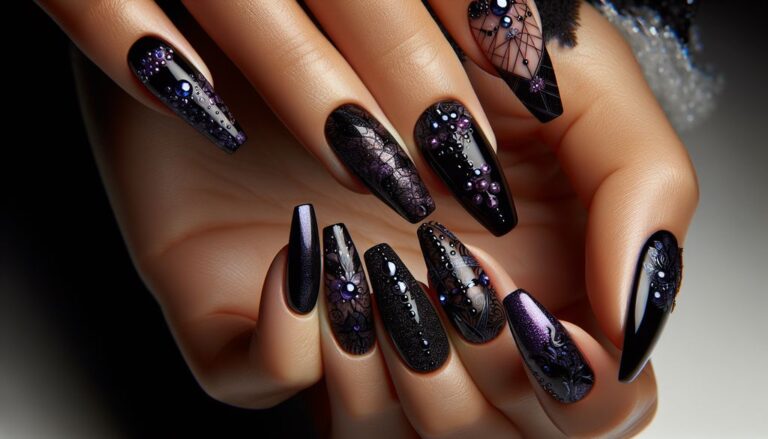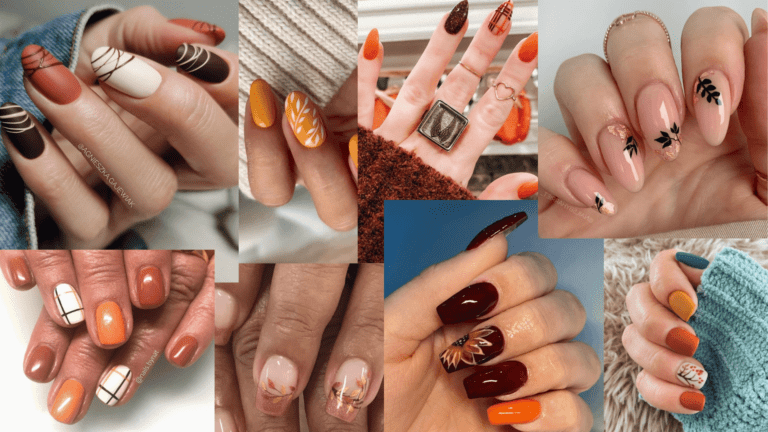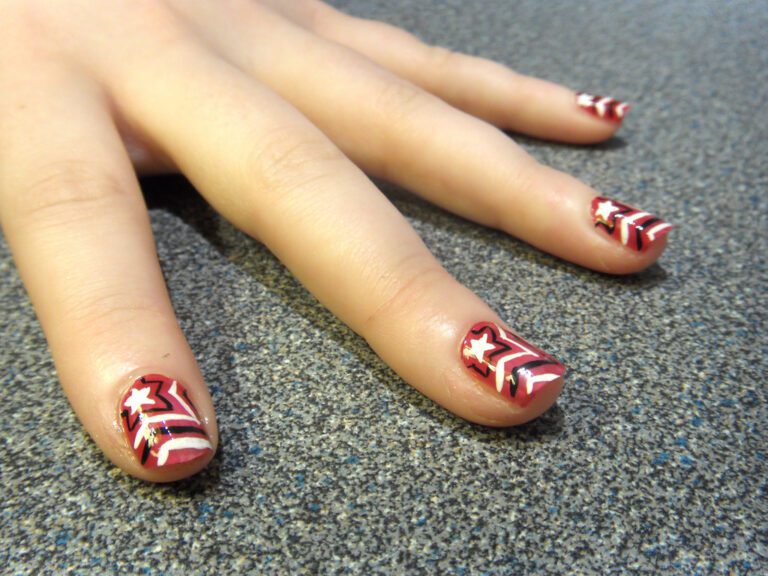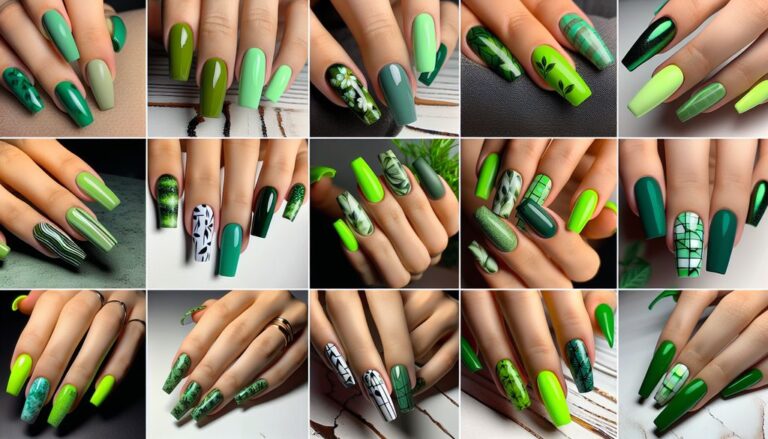“Green Enigma: When Nails Turn Green Unraveled”
Deprecated: mb_convert_encoding(): Handling HTML entities via mbstring is deprecated; use htmlspecialchars, htmlentities, or mb_encode_numericentity/mb_decode_numericentity instead in /home/u654140373/domains/nailinspire.com/public_html/wp-content/plugins/kadence-pro/dist/elements/elements-init.php on line 1267
Deprecated: Function utf8_decode() is deprecated in /home/u654140373/domains/nailinspire.com/public_html/wp-content/plugins/kadence-pro/dist/elements/elements-init.php on line 1275
Green nails can be a cause for concern and often raise questions about their underlying causes and potential health implications. In this article, we will delve into the mysterious case of green nails, uncovering the symptoms, culprits, medical insights, and the broader health implications associated with this enigmatic condition.
Key Takeaways
- Identifying the symptoms of green nail syndrome is crucial for early detection and treatment.
- Bacterial and fungal infections are common culprits behind green nails, requiring specific treatment approaches.
- Environmental factors, such as prolonged moisture and trauma, can contribute to the development of green nail syndrome.
- Diagnosis of green nail syndrome involves distinguishing between bacterial and fungal infections, guiding appropriate treatment plans.
- The psychological impact of green nail syndrome highlights the importance of addressing both the physical and emotional aspects of nail discoloration.
The Mysterious Case of Green Nails

Identifying the Symptoms of Green Nail Syndrome
Green Nail Syndrome (GNS) is characterized by a distinct greenish discoloration of the nails, often accompanied by other symptoms that may raise concern. The change in color can range from a light, pastel hue to a deep, dark green, depending on the severity and cause of the condition.
The primary symptom to look out for is the greenish hue of the nail bed, which is a clear indicator of GNS. However, individuals may also experience additional signs such as:
- Altered nail texture or thickness
- Brittleness or splitting of the nail
- A foul odor emanating from the affected nail
- Occasional pain or discomfort
Tip: Early detection of these symptoms is crucial for effective treatment and preventing further complications.
It’s important to note that while GNS is often associated with bacterial infections, other factors such as fungal infections or environmental influences can also contribute to the condition. Therefore, a thorough examination by a healthcare professional is essential to determine the underlying cause and appropriate treatment.
The Psychological Impact of Nail Discoloration
The appearance of green nails can be more than just a cosmetic concern; it often carries a psychological burden. Individuals with green nail syndrome may experience a range of emotional responses, from mild embarrassment to severe anxiety. The discoloration can lead to self-consciousness and a reluctance to engage in social activities or occupations that involve close hand contact.
For many, the hands are a source of pride and a means of expression. When nail discoloration occurs, it can affect one’s self-esteem and social interactions. In severe cases, it may even lead to social isolation or feelings of depression. It is important to recognize these psychological effects and address them with the same seriousness as the physical symptoms.
Tip: If you or someone you know is struggling with the psychological impact of nail discoloration, seeking support from a mental health professional can be beneficial. It’s crucial to treat both the mind and the body to ensure overall well-being.
Unveiling the Culprits Behind Green Nails

Bacterial Infections: Pseudomonas Aeruginosa
One of the primary villains in the tale of green nails is the Pseudomonas aeruginosa bacterium. This opportunistic pathogen is notorious for its role in causing infections when it invades a compromised nail bed. Characterized by a distinct green pigment known as pyocyanin, the bacteria can flourish beneath the nail plate, leading to the hallmark greenish discoloration.
The infection typically arises following nail trauma or in environments where nails are frequently exposed to moisture, such as in swimmers or individuals who frequently wash their hands. Symptoms may include not only the green coloration but also potential nail thickening and a foul odor.
- Treatment should be sought promptly to prevent further complications. A healthcare provider may prescribe a course of topical or oral antibiotics aimed at eradicating the bacteria. Additionally, keeping the affected nails dry and clean is crucial in the healing process.
Tip: Avoid prolonged exposure to water and moisture-rich environments to reduce the risk of Pseudomonas aeruginosa infections.
Fungal Infections and Their Role
Fungal infections play a significant role in the development of green nail syndrome. Moist environments and poor nail hygiene create favorable conditions for fungi to thrive, leading to discoloration and deterioration of the nail. It’s important to address fungal infections promptly to prevent further complications. Here’s a brief overview of common fungal infections associated with green nails:
- Candida: This yeast-like fungus can cause nail discoloration and thickening.
- Trichophyton: Known for causing nail infections, this fungus can lead to greenish discoloration.
- Aspergillus: This mold can affect the nails, resulting in greenish or yellowish discoloration.
It’s crucial to seek professional medical advice for accurate diagnosis and appropriate treatment. Early intervention is key to managing fungal infections effectively.
The Influence of Environmental Factors
While infections are a primary cause of green nails, environmental factors play a significant role in the development and exacerbation of the condition. Exposure to certain environments can predispose nails to discoloration. For instance, prolonged immersion in water or contact with detergents can compromise the nail’s protective barrier, making it more susceptible to bacterial and fungal invasions.
Occupations that involve frequent hand-washing or the use of harsh chemicals also increase the risk of developing green nail syndrome. Here’s a list of common environmental factors that can influence nail health:
- Prolonged exposure to water or moisture
- Contact with detergents and soaps
- Use of nail polish or artificial nails
- Exposure to chemicals in swimming pools
Tip: To minimize the risk, it’s advisable to wear gloves when handling chemicals and to keep the nails dry and clean.
Understanding the impact of these factors is essential for both prevention and treatment. By controlling environmental exposures, individuals can significantly reduce the likelihood of nail discoloration and maintain healthy nail appearance.
Medical Insights into Green Nail Syndrome

Diagnosis: Distinguishing Between Infections
When diagnosing green nail syndrome, it is crucial to differentiate between bacterial and fungal infections. This can be achieved through a thorough examination of the nail plate and the surrounding tissue. Additionally, laboratory tests, such as fungal cultures and bacterial swabs, may be conducted to confirm the type of infection present. It is important to note that misdiagnosis can lead to ineffective treatment and prolonged discomfort for the patient. Therefore, accurate diagnosis is essential for providing appropriate care and management of green nail syndrome.
Treatment Options for Nail Discoloration
When it comes to treating nail discoloration, it’s essential to consider the underlying cause. Topical treatments are often effective for mild cases, while more severe discoloration may require prescription medications. In some cases, a combination of oral and topical treatments may be necessary. It’s important to consult a healthcare professional to determine the most suitable treatment plan for your specific condition.
For those dealing with fungal infections, prescription oral antifungals such as terbinafine (Lamisil) or fluconazole (Diflucan) are traditionally used and have shown positive results. Additionally, over-the-counter antifungal treatments can be effective for milder cases. It’s crucial to follow the prescribed treatment regimen diligently to achieve the best outcomes.
Remember, consistency and patience are key when it comes to treating nail discoloration. It’s essential to adhere to the recommended treatment plan and maintain good nail hygiene to support the healing process.
If you’re unsure about the best course of action for your nail discoloration, seek guidance from a qualified healthcare professional for personalized advice and treatment recommendations.
Prevention Strategies and Best Practices
Preventing green nail syndrome involves a combination of personal hygiene and environmental awareness. Here are some best practices to keep your nails healthy and free from discoloration:
- Maintain nail hygiene by keeping nails clean and trimmed. Regular manicures and pedicures can help identify any early signs of infection.
- Use gloves when exposing hands to water for prolonged periods, or when using harsh chemicals, to protect the nail bed from bacterial and fungal agents.
- Ensure that nail tools are sterilized before use to prevent the spread of infection.
- Opt for breathable footwear and moisture-wicking socks to keep toes dry, especially if prone to sweating or in damp environments.
Tip: Always dry your hands and feet thoroughly after washing to minimize the risk of bacterial growth.
Incorporating these habits into your daily routine can significantly reduce the likelihood of developing green nail syndrome. It’s not just about aesthetics; it’s about maintaining the integrity of your nail’s health.
Beyond Aesthetics: The Health Implications of Green Nails

Potential Complications of Untreated Infections
Ignoring the signs of green nail syndrome can lead to severe health complications. When left untreated, a simple case of nail discoloration might escalate into a more serious condition. For instance, a bacterial infection such as one caused by Pseudomonas aeruginosa can progress to bacteremia, where the bacteria enter the bloodstream.
This can further develop into life-threatening conditions like sepsis or septic shock, which require immediate medical attention. It’s crucial to understand that what starts as a cosmetic concern can have profound implications for one’s overall health.
Tip: Early diagnosis and prompt treatment are key in preventing the progression of nail infections to more severe health issues.
Additionally, chronic nail infections can lead to permanent changes in the nail structure, causing pain and discomfort that may interfere with daily activities. It’s essential to address nail discoloration early to avoid these potential complications.
The Connection Between Nail Health and Overall Well-being
The health of our nails is more than just an aesthetic concern; it is a window into our overall well-being. Nail discoloration, such as the green tint associated with certain infections, can sometimes be the first clue to underlying health issues. It’s essential to recognize that our nails can signal systemic problems, nutritional deficiencies, or serious infections that require attention.
Healthy nails are typically smooth, uniform in color, and free of any distortion or discoloration. Changes in nail health can affect not only our appearance but also our physical and psychological comfort. For instance, nail abnormalities can interfere with daily activities, leading to discomfort or even pain when performing tasks.
- Psychological well-being: The appearance of one’s nails can significantly impact self-esteem and social interactions. Healthy-looking nails contribute to a positive self-image and can enhance social confidence.
- Physical health: Nails can reveal signs of systemic health issues, such as liver disease, heart conditions, or lung problems. Early detection through nail changes can lead to prompt medical intervention.
Maintaining nail health is not just about beauty; it’s a proactive step towards preserving overall health. Regular observation and care for our nails can prevent potential health complications and support a healthier lifestyle.
When it comes to nail health, the color of your nails can reveal a lot about your overall well-being. Green nails, in particular, can be indicative of underlying health issues that should not be ignored. From fungal infections to liver problems, green nails can signal the need for medical attention. At NAILinspire.com, we are dedicated to providing valuable information and resources to help you understand and address nail health concerns. Visit our website to explore a wide range of nail care tips, trends, and designs. Take the first step towards healthier nails today!
Frequently Asked Questions
What causes nails to turn green?
Green nails can be caused by bacterial or fungal infections, as well as environmental factors such as prolonged exposure to moisture or chemicals.
Is green nail syndrome contagious?
Green nail syndrome caused by bacterial or fungal infections can be contagious, especially if proper hygiene and precautions are not taken.
How can I prevent green nails?
To prevent green nails, it’s important to practice good nail hygiene, avoid prolonged exposure to moisture, and use protective gloves when handling chemicals or working in wet environments.
What are the treatment options for green nails?
Treatment options for green nails include antifungal or antibacterial medications, proper nail care, and, in severe cases, surgical intervention to remove the affected nail.
Are green nails a sign of a serious health condition?
While green nails can be alarming, they are not always indicative of a serious health condition. However, it’s important to seek medical attention to rule out underlying infections or health issues.
Can green nails cause pain or discomfort?
In some cases, green nails caused by infections may lead to discomfort, pain, or changes in nail texture. Seeking prompt medical treatment can help alleviate these symptoms.







